Imagine a world where architecture seamlessly integrates with nature, creating spaces that not only inspire us but also promote environmental sustainability.
Biophilic Architecture is revolutionizing the way we design our living and work spaces.
By integrating nature into modern design, architects are creating environments that not only look stunning, but also promote health and well-being.

Today, we spend a staggering 90% of our time indoors between work and home.
Biophilic architecture aims to transform these indoor spaces into habitats that satisfy our inherent need to affiliate with nature.
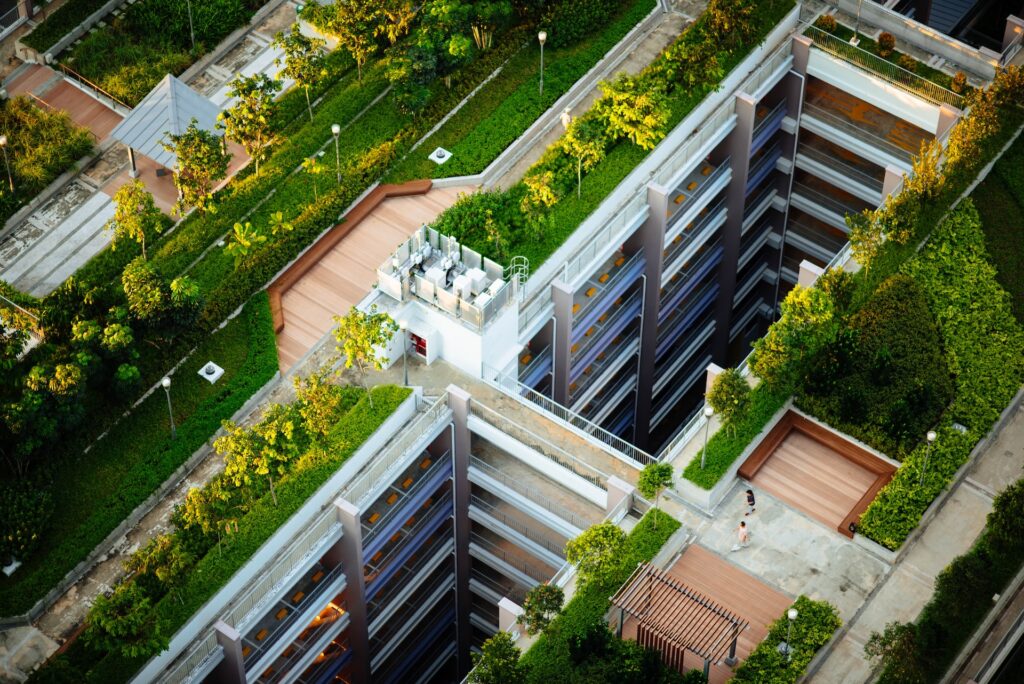
What is Biophilic Architecture?
Biophilic Theory
At the core of biophilic architecture is the biophilic theory, which highlights the psychological and physiological benefits of nature on human beings.
Numerous studies have shown that exposure to nature and natural elements can reduce stress, increase cognitive performance, enhance creativity, and improve overall mood and well-being.

Biophilic theory suggests that incorporating elements such as natural light, vegetation, water features, and views of nature into architectural designs can have profound positive effects on occupants.
Biophilic Values
Biophilic values are the deep appreciation and inherent connection humans have with nature.
These values stem from the belief that nature is not just to be exploited, but cherished, protected, and celebrated.
Difference between Biophilic Architecture and Green Architecture
Before delving into the specifics of biophilic architecture, a quick note on the difference between biophilic architecture and green architecture.
While both concepts aim to create environmentally friendly and sustainable structures, they approach this goal from different angles.
Green architecture, (also known as sustainable architecture) focuses primarily on reducing the negative impact of buildings on the environment.
It emphasizes energy efficiency, the use of renewable resources, and minimizing waste and pollution.
Green architecture looks to minimize the ecological footprint of the built environment.
Biophilic architecture goes beyond sustainability and incorporates elements of the natural world to enhance the well-being and connection of occupants with their environment.
It recognizes that human beings have an innate need to affiliate with nature and seeks to create spaces that satisfy this connection.
Biophilic architecture aims to create environments that promote physical and mental health, productivity, and overall well-being.
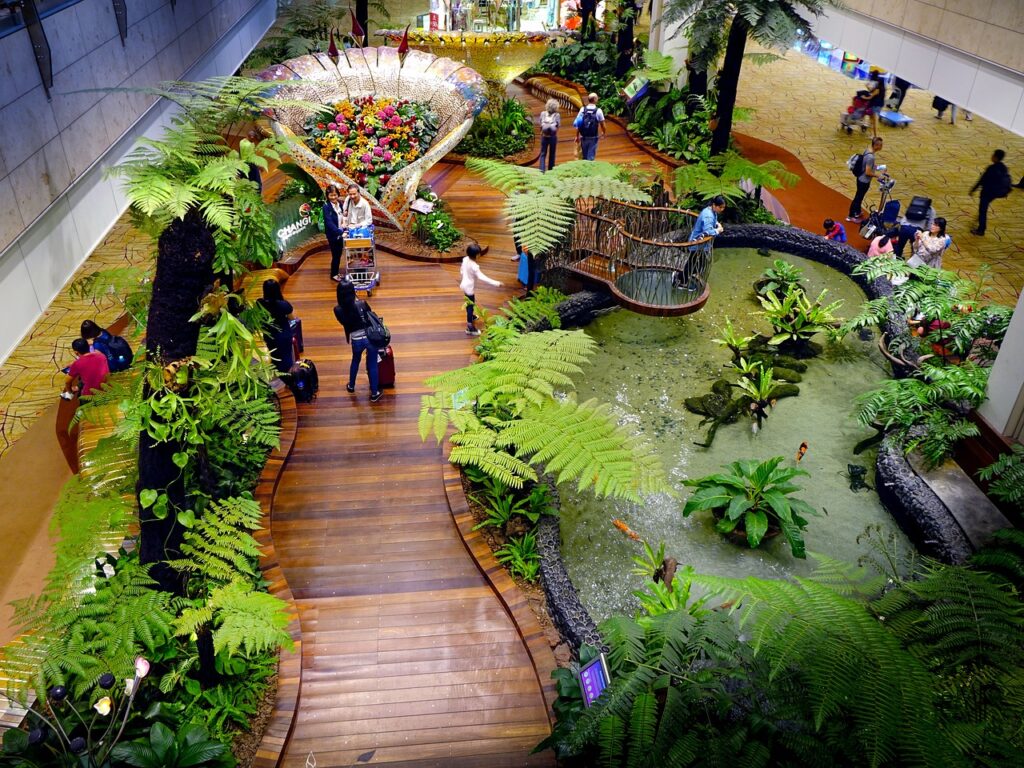
What Makes a Design Biophilic?
For a design to be truly biophilic, there are several crucial elements that must be included.
Biophilic Architecture Characteristics
These key elements are essential in order to achieve the physical and mental well-being rooted in the concept of biophilia.
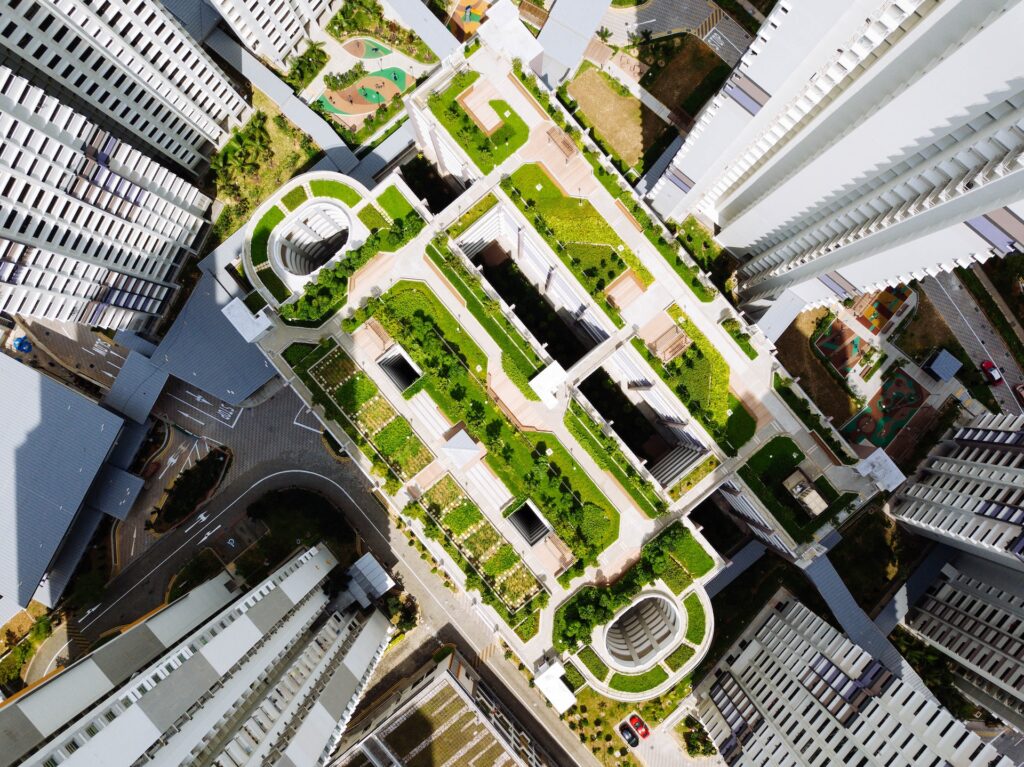
1- Incorporating Nature’s Contributions to Human Health and Well-being
Biophilic design centers around the aspects of the natural world that have positively impacted human health and productivity.
2- Considering the Whole Habitat, not just Isolated Occurrences
Biophilic design goes beyond incorporating a single element of nature and instead emphasizes the importance of creating a cohesive and interconnected habitat.
Just as all organisms exist within integrated ecosystems, buildings and cities should be designed as holistic environments.
3- Creating a Connection with the Local Environment
Designers should strive to incorporate elements that reflect and celebrate the unique natural features of the surrounding area.
This essentially bridges a connection between the built environment and the natural surroundings already there.
4- Enhancing Sensory Experiences and Delighting the Senses
Biophilic design aims to engage the senses and create a multisensory experience within the built environment. More on this later.
5- Promoting Access to Nature and Encouraging Movement
This provides opportunities for individuals to access and interact with nature.
Incorporating elements like outdoor spaces, gardens, and pathways not only allows people to connect with the natural world but also encourages physical movement and promotes a healthier lifestyle.
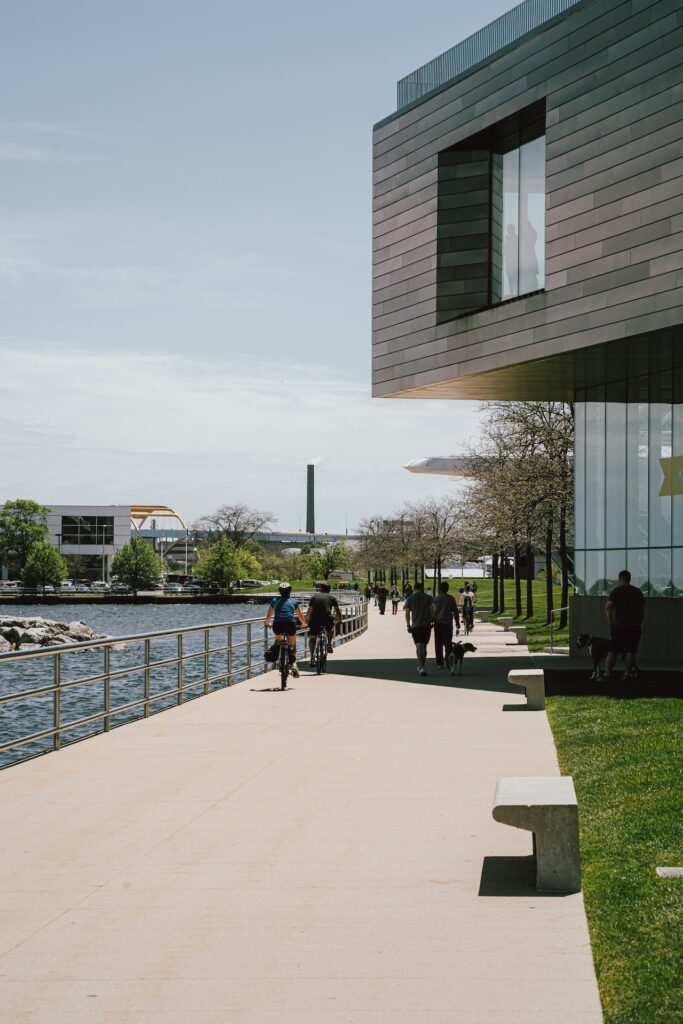
The Three Pillars of Biophilic Design
1. Nature in the Space
The first pillar of biophilic design revolves around integrating nature directly into the built environment. This can be achieved through various means, such as:
- Indoor Plants: Provides visual appeal, improves air quality and promotes a sense of tranquility.
- Natural Materials: Materials like wood, stone, and bamboo can create a connection to the outdoors, adding warmth and authenticity to the space.
- Water Features: The inclusion of water features, such as fountains or indoor ponds, can mimic the calming effect of natural bodies of water, promoting relaxation and reducing stress.
2. Natural Analogues
The second pillar of biophilic design involves representations or simulations of nature within the built environment. These analogues can help create a sense of connection to the natural world. Examples include:
- Artwork and Murals: Pieces that showcase nature scenes or landscapes can evoke feelings of being outdoors and enhance the overall ambiance of a space.
- Pattern and Texture: Incorporating patterns and textures inspired by nature can add visual interest and create a calming effect.
- Light and Shadow: Strategic lighting design that mimics natural light patterns can create a more dynamic and inviting atmosphere.
3. Nature of the Space
The third and final pillar of biophilic design focuses on creating spaces that mimic or emulate natural ecosystems. Key aspects include:
- Views of Nature: Whether it’s a window overlooking a park or a courtyard filled with greenery, intentional sightline can have a profound impact on the natural aesthetic.
- Natural Light: It not only reduces the need for artificial lighting but also has a positive impact on our circadian rhythm, mood, and overall well-being.
- Connection to the Outdoors: Providing access to outdoor spaces, such as gardens, courtyards, or rooftop terraces, allows occupants to experience nature firsthand and reap its benefits.

5 Senses of Biophilic Design
As stated above, biophilic architecture looks on engage all of your senses within it’s design. This further enhances the experience of the space created.
- Sight – Our sense of sight is one of the most powerful ways we interact with our environment. By bringing the outdoors in, we can create a visually stimulating and calming space that enhances our overall experience.
- Hearing – Biophilic design utilizes soothing natural sounds, such as flowing water or birdsong, to create a tranquil atmosphere. By incorporating elements like indoor water features or strategically placed speakers emitting nature sounds, we can foster a sense of calm and relaxation. In addition, green walls can help dampen unnecessary noise.
- Touch -Biophilic design encourages tactile experiences by incorporating natural materials like wood, stone, and plants. From natural textures on walls and floors to the use of living green walls, these elements provide a sense of grounding and connection to nature.
- Smell – Our sense of smell is closely tied to our emotions and memories. Biophilic design incorporates natural scents, such as the aroma of fresh flowers or the earthy scent of a forest, to create an uplifting and invigorating atmosphere.
- Taste – While taste may not be directly related to biophilic design, it can still be influenced by our environment. By creating spaces that encourage healthy eating and a connection to nature, biophilic design can indirectly impact our sense of taste. For example, incorporating a garden or herb wall in a workspace can inspire employees to choose healthier food options, ultimately benefiting their overall well-being.
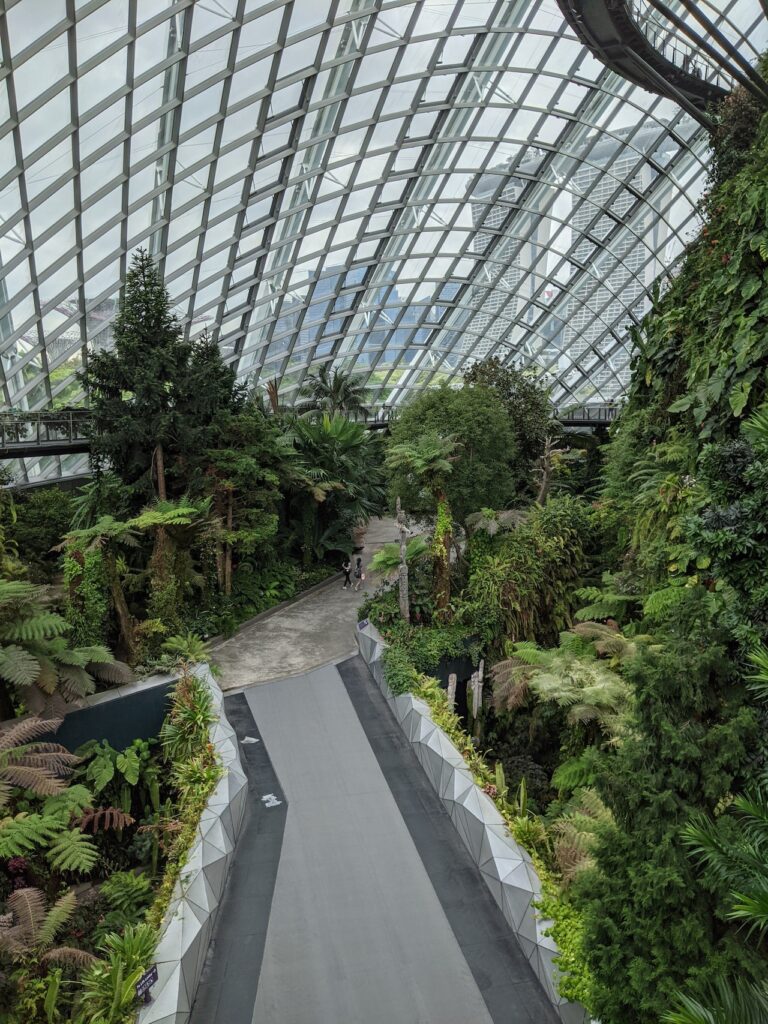
5 Benefits of Biophilic Design
More than it’s stunning aesthetics, lets go over the wide-ranging impactful benefits of biophilic architecture.
1. Improved Air Quality
Plants naturally absorb carbon dioxide and release oxygen, thereby improving the air we breathe.
Additionally, they help combat dry air, a common problem in air-conditioned environments, by increasing humidity levels.
Moreover, plants have the remarkable ability to absorb volatile organic compounds (VOCs), which are harmful chemicals often found in cleaning products, carpets, and electronics.
2. Increased Creativity and Productivity
Studies have shown that biophilic elements have a positive impact on creativity and productivity in the workplace.
Research conducted at Exeter University revealed that employees working in environments adorned with even just a few houseplants exhibited a 15% increase in productivity!
3. Stress Reduction and Mental Well-being
Numerous studies have shown that exposure to nature has a calming effect on the human mind and helps alleviate stress.
The NIH notes that even a modest amount of nature indoors can provide stress relief.
By incorporating natural elements like plants, water features, and natural patterns into our surroundings, we can create spaces that promote relaxation and mental well-being.
4. Enhanced Cognitive Function
Biophilic design has been shown to improve cognitive function in various settings.
5. Increased Well-being and Satisfaction
Biophilic architecture boosts well-being and satisfaction. Surrounded by nature, people often feel more balanced and content. Biophilic design connects the built environment to the natural world, deepening our bond with nature. This connection enhances satisfaction and promotes happiness.
5 Elements of Nature Design
Biophilic design seeks to incorporate elements of nature into architectural and interior design.
By integrating natural elements, biophilic design aims to achieve the benefits listed above.
Here are five key biophilic design elements that can be incorporated into architectural projects.
1. Natural Light and Views
Natural light boosts mood, productivity, and can help regulates our circadian rhythm. Architects can maximize it by adding windows and skylights, creating openness and a connection to the outdoors.
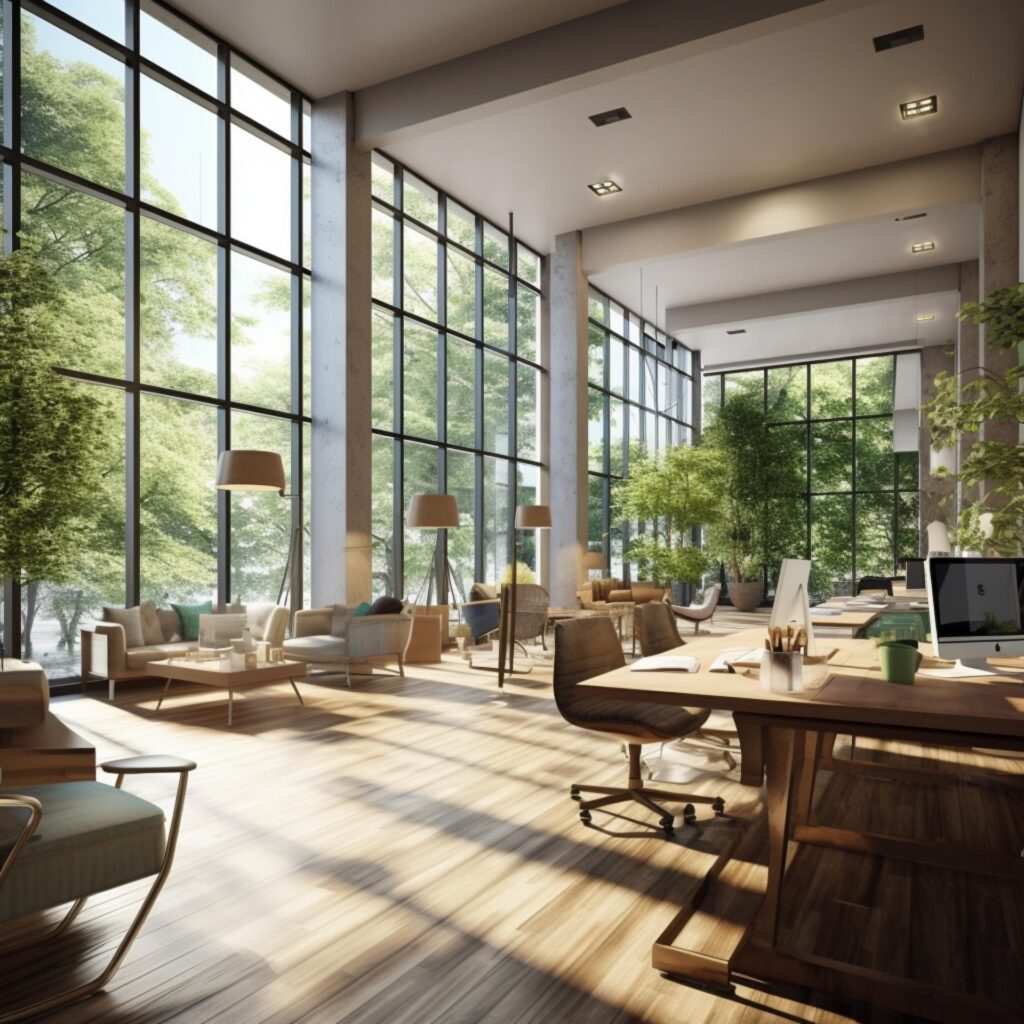
Views of nature, like green landscapes or water bodies, also help calm us and improve well-being.
2. Use of Natural Materials
Utilizing materials such as wood, stone, bamboo and cork help create a natural authenticity.

These types of materials make indoor spaces healthier by reducing the use of harmful synthetic materials.
Sustainable, local materials make projects even more eco-friendly.
3. Incorporating Greenery and Living Walls
Adding indoor plants improves air quality, enhances aesthetics, and connects us to nature.
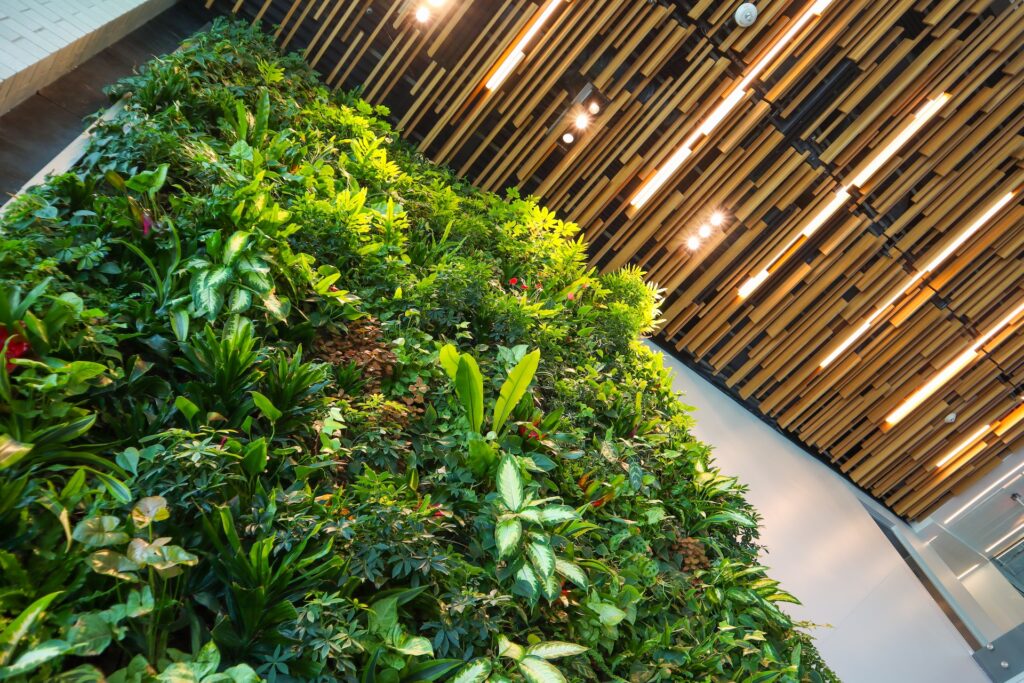
Living walls or vertical gardens can serve as natural artwork that enhances the space while also providing insulation and noise reduction.
4. Water Features and Biomorphic Shapes
Water features like fountains or indoor ponds are popular in biophilic design. The sound and sight of flowing water create a serene atmosphere, promoting relaxation and reducing stress.
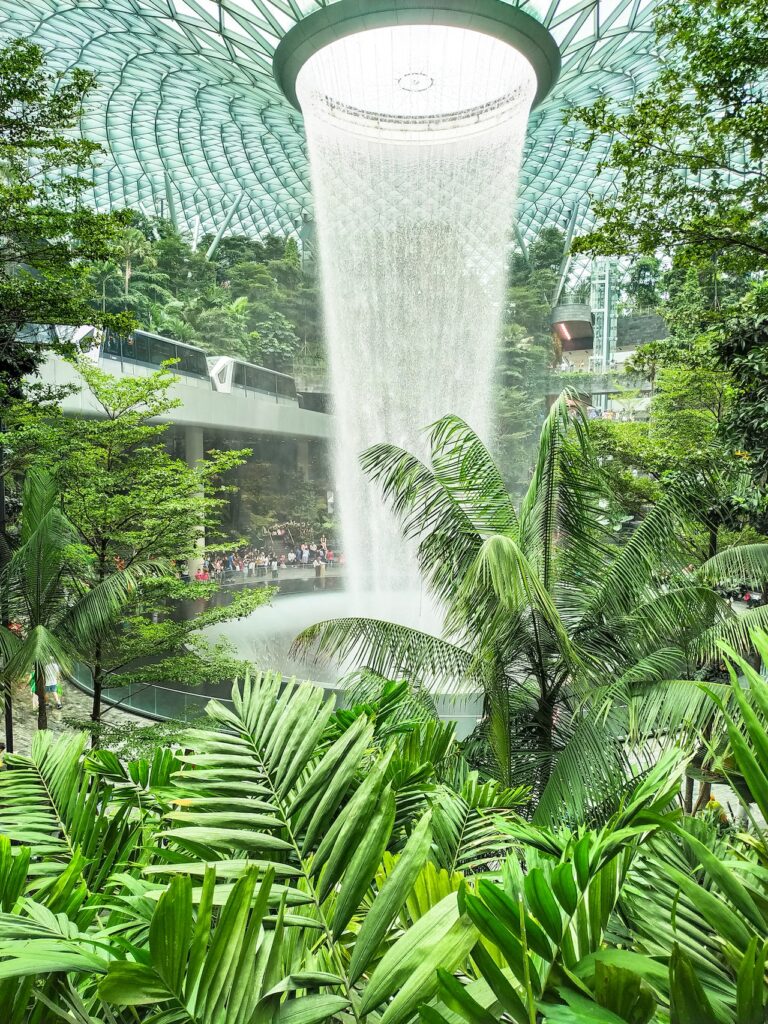
Additionally, adding organic shapes to furniture, lighting fixtures, and architectural details adds elegance and a connection to nature.
5. Sustainable Building Practices
Utilizing energy-efficient systems, renewable energy sources, and optimizing resource usage are vital to biophilic design.
By adding features like solar panels, rainwater harvesting systems, and efficient insulation, architects can reduce environmental impact and create healthier, energy-efficient spaces for occupants.
Biophilic Architecture in Practice
In this section, we will explore the practical application of biophilic architecture in:
- Urban areas
- Residential spaces
- Commercial buildings
- Healthcare facilities
Biophilic Architecture in Urban Settings
Even in densely populated urban areas, biophilic architecture has found its place, creating pockets of nature amidst the concrete jungle.
One notable example is the High Line in New York City, a public park built on an elevated railway track.
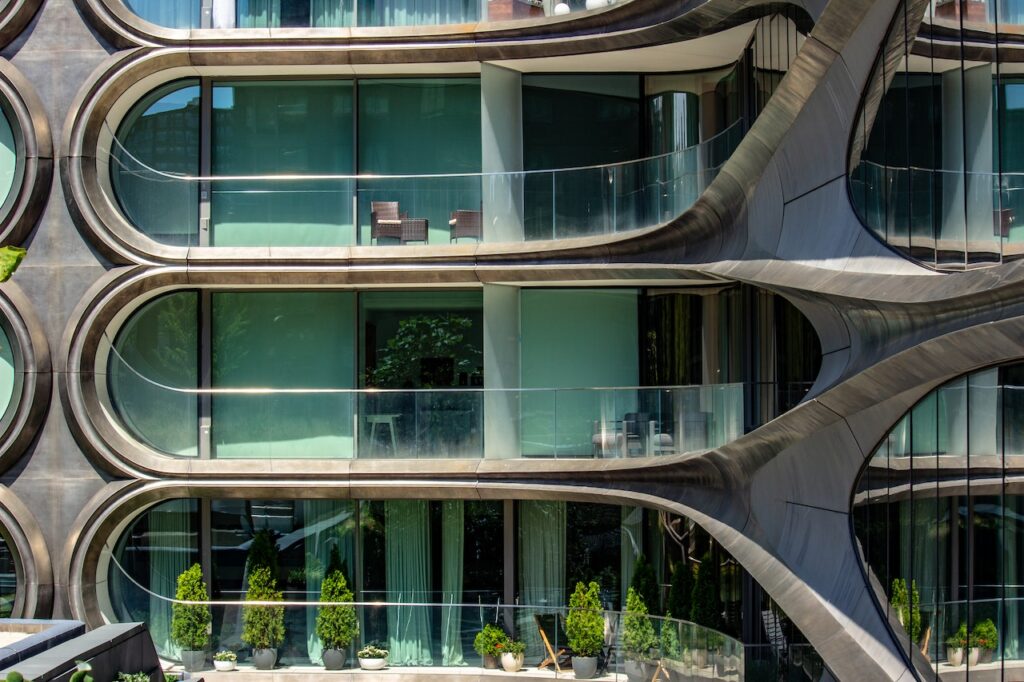
Lush greenery, native plants, and seating areas provide a respite from the busy streets below, offering a tranquil space for relaxation and recreation.
In Singapore, the Gardens by the Bay showcase the integration of nature and architecture on a grand scale. The Supertree Grove, with its towering vertical gardens, not only adds a touch of green to the skyline but also serves as an innovative way to harness solar energy and collect rainwater.
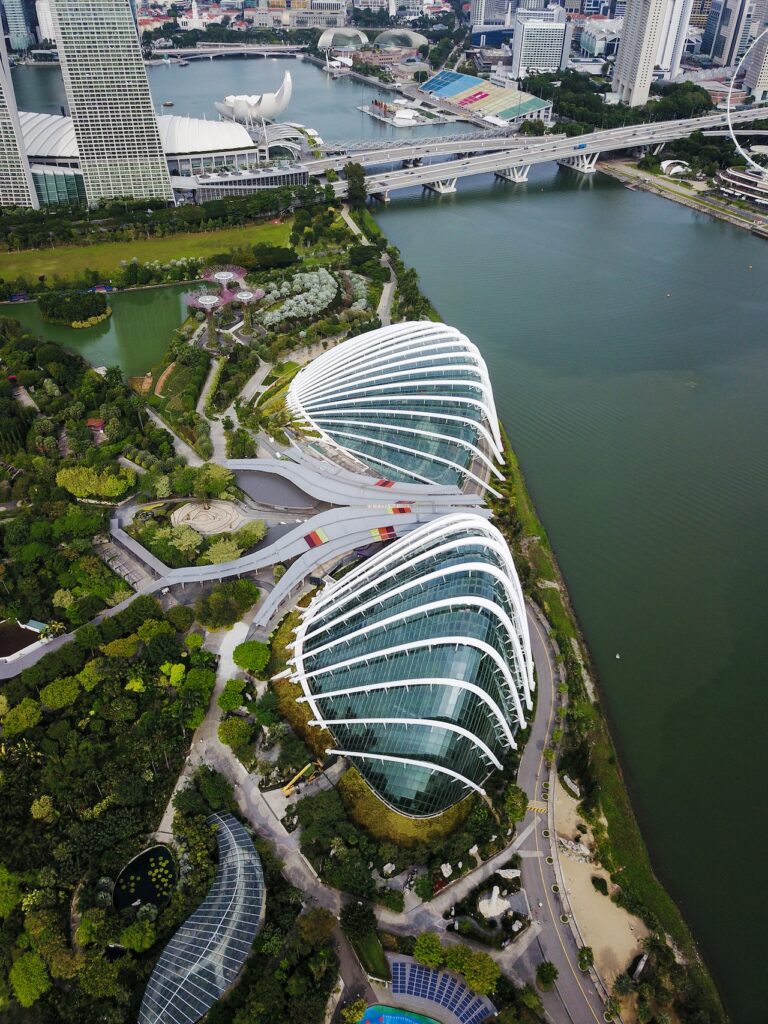
Biophilic Design in Residential Spaces
Biophilic design can improve homes by adding natural elements like large windows for more light, indoor gardens to bring the outdoors in, and using materials like wood and stone.
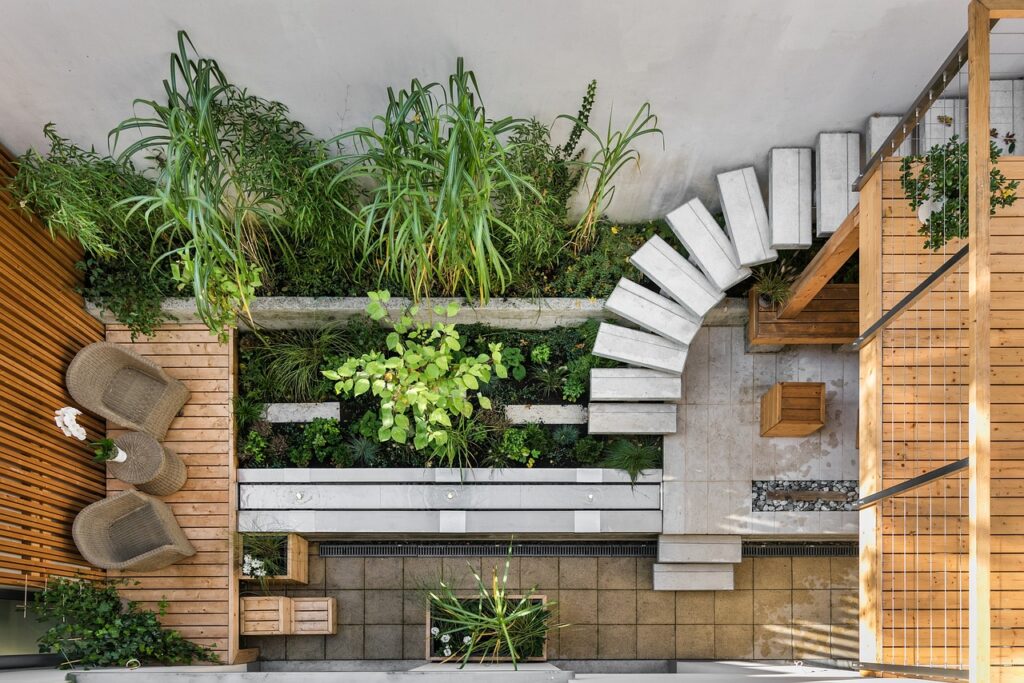
Want to learn how to create this cozy design in your own home?
Here’s an article on biophilic interior design!
Biophilic Architecture in Commercial and Office Buildings
Employers are recognizing the positive impact of biophilic elements on employee well-being and productivity.

One iconic example of biophilic architecture in a commercial setting is the Amazon Spheres in Seattle.
These spherical glass structures house over 40,000 plants from around the world, creating a lush and inspiring environment for employees to work in.
How about an article on introducing biophilic design into your office!
Biophilic Design in Healthcare Facilities
In healthcare facilities, the integration of biophilic design principles can contribute to the well-being and recovery of patients.
Hospitals and clinics are incorporating healing gardens, natural light, and views of nature to create a soothing and calming environment for patients.

These design elements can help create a sense of comfort and promote healing, making the overall healthcare experience more positive.
Challenges and Considerations Biophilic Architecture
While we have discussed the numerous benefits of biophilic architecture, there are challenges and considerations that architects and designers must navigate to successfully implement these principles.
Limited Availability of Natural Resources
Biophilic design faces resource challenges. Adding plants and natural materials largescale needs a steady supply.
This can be difficult in urban areas or places with limited access.
Sourcing and maintaining these elements can be costly, limiting budgeted projects.
Learn more about sustainable sourcing of natural materials.
Overcoming Cost and Implementation Challenges
Adding natural elements and biophilic design may require more resources during construction. But these investments can bring long-term benefits. Studies show biophilic design boosts productivity, well-being, and cuts healthcare costs for occupants.
To address cost challenges, it’s crucial to consider the ROI of biophilic architecture. By emphasizing the financial, social, and environmental benefits, architects can make a compelling case for using biophilia.
Additionally, exploring sustainable materials and techniques can help overcome cost concerns.
Here’s an article on the economics of biophilia.
Balancing Biophilia with Modern Building Standards
It is essential to strike a balance between biophilia and modern building standards. Building codes and regulations often prioritize safety, energy efficiency, and structural integrity. Integrating biophilic elements should not compromise these fundamental requirements.

Architects should learn local building codes and work with engineers and other pros to smoothly add biophilic design features. By taking a holistic approach, architects can include biophilic elements while still meeting building standards.
Ensuring Maintenance and Long-Term Viability
Biophilic architecture is not a one-time implementation; it requires ongoing maintenance and care to ensure its longevity and effectiveness. Living walls, green roofs, and indoor plantings, for example, require regular attention to thrive and provide the desired benefits.
To keep biophilic design features healthy and working for a long time, make a maintenance plan. It should cover irrigation, plant care, and pest control. Getting help from pros or experienced landscape architects will keep the biophilic elements vibrant and functional.
The Future of Biophilic Architecture
Growing Importance of Biophilic Design in Sustainable Architecture
Biophilic architecture has become increasingly popular in recent years, and its role in sustainable design is crucial. As we aim to construct eco-friendly and energy-efficient buildings, it is essential to integrate nature into our constructed surroundings.
Additionally, biophilic design recognizes the innate human connection to nature and aims to create harmonious environments that promote well-being and productivity. Given the rise of the mental health issues, the benefits of indoor nature exposure cannot be underestimated.
Integrating biophilic design into sustainable architecture has many benefits. It improves air quality, reduces stress, boosts cognitive function, and enhances overall health. Moreover, when people feel connected to nature, they develop a sense of responsibility for the environment, leading to a stronger commitment to sustainable living.
Technological Advancements and Biophilic Integration
With the advent of smart home technology, it is now possible to automate and optimize the use of natural resources, such as lighting and temperature control, to mimic the patterns found in nature.
Smart sensors can detect natural light levels and adjust artificial lighting accordingly, ensuring that indoor spaces maintain a connection with the outside world.
Similarly, automated shading systems can regulate solar heat gain, reducing the need for excessive air conditioning and lowering energy consumption.
Smart sensors could potentially be utilized to configure a space for different purposes. For example, if you want to use the room for studying, the sensors could adjust the lighting, scents, ambient sounds, and temperature to optimize cognitive function. And if you later want to use the same area for relaxation, the settings would change to create a calming atmosphere. There is a strong demand for technology to fully embrace biophilic design.
Virtual reality (VR) and augmented reality (AR) have great potential for integrating nature into architecture. They transport people to virtual natural environments, reducing stress and improving mental well-being.
Conclusion
Biophilic architecture is a sustainable approach that offers numerous benefits to both humans and the environment.
Biophilic design not only enhances the overall aesthetic appeal of buildings but also promotes improved physical and mental well-being.
What’s your favorite aspect of biophilic architecture?
You can let me know all about it in the comments below!
Until next time, stay cozy my friends.






One Comment